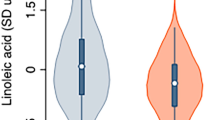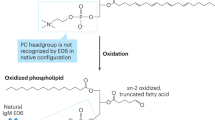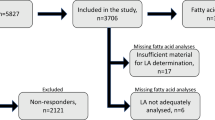Abstract
Objective: To assess the oxidative burden of a highly concentrated compound of n-3 PUFAs as compared to corn oil by measuring thiobarbituric acid–malondialdehyde complex (TBA–MDA) by HPLC. We also studied the influence on TBA–MDA of statins combined with n-3 PUFAs or corn oil.
Design: A prospective, randomised, double-blind, controlled study.
Setting: One hospital centre in Stavanger, Norway.
Subjects: A total of 300 subjects with an acute myocardial infarction (MI).
Interventions: Gelatine capsules, containing 850–882 mg EPA and DHA as concentrated ethylesters, or 1 g of corn oil, were ingested in a dose of two capsules twice a day for at least 1 y. Alpha-tocopherol (4 mg) was added to all capsules to protect the PUFAs against oxidation.
Results: After 1 y TBA–MDA increased modestly in the n-3 PUFA group (n=125), as compared to the corn oil group (n=130), P=0.027. Multiple linear regression analyses of fatty acids in serum total phospholipids (n=56) on TBA–MDA measured after 12 months intervention, showed no dependency. Performing best subsets regression, serum phospholipid concentration of arachidonic acid (20:4 n-6 PUFA) was identified as a predictor of TBA–MDA at 12 months follow-up, P=0.004.
We found no impact of statins on TBA–MDA.
Conclusion: TBA–MDA increased modestly after long-term intervention with n-3 PUFAs compared to corn oil post-MI, suggesting biological changes induced by n-3 PUFAs, rather than simply reflecting their concentration differences. The peroxidative potential of n-3 PUFAs was not modified by statin treatment.
Sponsorship: Pharmacia A/S and Pronova A/S, Norway.
This is a preview of subscription content, access via your institution
Access options
Subscribe to this journal
Receive 12 print issues and online access
$259.00 per year
only $21.58 per issue
Buy this article
- Purchase on Springer Link
- Instant access to full article PDF
Prices may be subject to local taxes which are calculated during checkout
Similar content being viewed by others
References
Alpert JS & Thygesen K (2000): The Joint European Society of Cardiology/American College of Cardiology Committee for the redefinition of myocardial infarction. Eur Heart J. 21, 1502–1513.
Anoopkumar-Dukie S, Walker RB & Daya S (2001): A sensitive and reliable method for the detection of lipid peroxidation in biological tissues. J. Pharm. Pharmacol. 53, 263–266.
Armstrong D & Browne R (1994): The analysis of free radicals, lipid peroxides, antioxidant enzymes and compounds related to oxidative stress as applied to the clinical chemistry laboratory. In Free Radicals in Diagnostic Medicine:A Systems Approach to Laboratory, Technology, Clinical Correlations, and Antioxidant Therapy, ed. D Armstrong, pp 43–58. New York: Plenum Press, XVI.
Arnesen E, Refsum H, Bonaa KH, Ueland PM, Forde OH & Nordrehaug JE (1995): Serum total homocysteine and coronary heart disease. Int. J. Epidemiol. 24, 704–709.
Avogaro P, Bittolo Bon G & Cazzolato G (1988): Presence of a modified low density lipoprotein in humans. Arteriosclerosis 8, 79–87.
Bittolo-Bon G, Cazzolato G, Alessandrini P, Soldan S, Casalino G & Avogaro P (1993): Effects of concentrated DHA and EPA supplementation on LDL peroxidation and vitamin E status in type HB hyperlipidemic patients. In Omega-3 Fatty Acids, eds CA Drevon, I Baksaas & HE Krokan, pp 51–58. Basel, Switzerland: Birkhauser-Verlag/Switzerland.
Bonanome A, Biasia F, De Luca M, Munaretto G, Biffanti S, Pradella M & Pagnan A (1996): n-3 Fatty acids do not enhance LDL susceptibility to oxidation in hypertriacylglycerolemic hemodialyzed subjects. Am. J. Clin. Nutr. 63, 261–266.
Boyd HC, Gown AM, Wolfbauer G & Chait A (1989): Direct evidence for a protein recognized by a monoclonal antibody against oxidatively modified LDL in atherosclerotic lesions from a Watanabe heritable hyperlipidemic rabbit. Am. J. Pathol. 135, 815–824.
Brude IR, Drevon CA, Hjermann I, Seljeflot I, Lund-Katz S, Saarem K, Sandstad B, Solvoll K, Halvorsen B, Arnesen H & Nenseter MS (1997): Peroxidation of LDL from combined-hyperlipidemic male smokers supplied with ω–3 fatty acids and antioxidants. Arterioscler. Thromb. Vasc. Biol. 17, 2576–2588.
Burstein M, Scholnick HR & Morfin R (1970): Rapid method for the isolation of lipoprotein from human serum by precipitation with polyanions. J. Lipid. Res. 11, 583–595.
Cavalca V, Cighetti G, Bamonti F, Loaldi A, Bortone L, Novembrino C, De Franceschi M, Belardinelli R & Guazzi MD (2001): Oxidative stress and homocysteine in coronary artery disease. Clin. Chem. 47, 887–892.
Connor SL & Connor WE (1997): Are fish oils beneficial in the prevention and treatment of coronary artery disease? Am. J. Clin. Nutr. 66 (Suppl), S1020–S1031.
Cosgrove JP, Church DF & Pryor WA (1987): The kinetics of the autoxidation of polyunsaturated fatty acids. Lipids 22, 299–304.
Dargel R (1992): Lipid peroxidation—a common pathogenetic mechanism? Exp. Toxicol Pathol. 44, 169–181.
Diaz-Velez CR, Garcia-Castineiras S, Mendoza-Ramos E & Hernandez-Lopez E (1996): Increased malondialdehyde in peripheral blood of patients with congestive heart failure. Am. Heart J. 131, 146–152.
Duthie GG, Beattie JA, Arthur JR, Franklin M, Morrice PC & James WPT (1994): Blood antioxidants and indices of lipid peroxidation in subjects with angina pectoris. Nutrition 10, 313–316.
Eritsland J, Arnesen H, Seljeflot I & Høstmark AT (1995): Long-term metabolic effects of n-3 polyunsaturated fatty acids in patients with coronary artery disease. Am. J. Clin. Nutr. 61, 831–836.
Frankel EN, Parks EJ, Xu R, Schneeman BO, Davis PA & German JB (1994): Effect of n-3 fatty acid-rich fish oil supplementation on the oxidation of low density lipoproteins. Lipids 29, 233–236.
Gerhardt W, Waldenstrøm J, Horder M, Hofvendahl S, Billstrøm R, Ljungdahl R, Berning H & Bagger P (1982): Creatine kinase and creatine kinase B-subunit activity in serum in cases of suspected myocardial infarction. Clin. Chem. 28, 277–283.
GISSI-Prevenzione Investigators (1999): Dietary supplementation with n-3 polyunsaturated fatty acids and vitamin E after myocardial infarction: results of the GISSI-Prevenzione trial. Lancet 354, 447–455.
Gutteridge JM (1986): Aspects to consider when detecting and measuring lipid peroxidation. Free Radic. Res. Commun. 1, 173–184.
Halliwell B & Chirico S (1993): Lipid peroxidation: its mechanism, measurement, and significance. Am. J. Clin. Nutr. 57 (Suppl), S715–S725.
Hansen JB, Berge RK, Nordøy A & Bønaa KH (1998): Lipid peroxidation of isolated chylomicrons and oxidative status in plasma after intake of highly purified eicosapentaenoic or docosahexaenoic acids. Lipids 33, 1123–1129.
Harats D, Dabach Y, Hollander G, Ben-Naim M, Schwartz R, Berry EM, Stein O & Stein Y (1991): Fish oil ingestion in smokers and nonsmokers enhances peroxidation of plasma lipoproteins. Atherosclerosis 90, 127–139.
Hetland Ø, Gøransson L & Nilsen DWT (1995): Cardiac troponin-T immunoassay on biotin–streptavidin-coated microplates, preliminary performance in acute myocardial infarction. Scand. J. Clin. Lab. Invest. 55, 701–713.
Higdon JV, Liu J, Du SH, Morrow JD, Ames BN & Wander RC (2000): Supplementation of postmenopausal women with fish oil rich in eicosapentaenoic acid and docosahexaenoic acid is not associated with greater in vivo lipid peroxidation compared with oils rich in oleate and linoleate as assessed by plasma malondialdehyde and F2-isoprostanes. Am. J. Clin. Nutr. 72, 714–722.
Janero DR (1990): Malondialdehyde and thiobarbituric acid-reactivity as diagnostic indices of lipid peroxidation and peroxidative tissue injury. Free Rad. Biol. Med. 9, 515–540.
Jayakumari N, Ambikakumari V, Balakrishnan KG & Subramonia IK (1992): Antioxidant status in relation to free radical production during stable and unstable angina syndromes. Atherosclerosis 94, 183–190.
Johansen O, Abdelnoor M, Brekke M, Seljeflot I, Høstmark AT & Arnesen H (2001): Predictors of restenosis after coronary angioplasty. A study on demographic and metabolic variables. Scand. Cardiovasc. J. 35, 86–91.
Johansen O, Seljeflot I, Høstmark AT & Arnesen H (1999): The effect of supplementation with omega-3 fatty acids on soluble markers of endothelial function in patients with coronary heart disease. Arterioscler. Thromb. Vasc. Biol. 19, 1681–1686.
Kharb S, Singh V, Ghalaut PS & Singh GP (2000): Oxidative stress after acute myocardial infarction: effect of thrombolytic treatment. J. Assoc. Physicians India 48, 578–580.
Kinsella JE, Lokesh B & Stone RA (1990): Dietary n-3 polyunsaturated fatty acids and amelioration of cardiovascular disease: possible mechanisms. Am. J. Clin. Nutr. 52, 1–28.
Lapenna D, Ciofani G, Pierdominico SD, Giamberardino MA & Cuccurullo F (2001): Reaction conditions affecting the relationship between thiobarbituric acid reactivity and lipid peroxides in human plasma. Free Radic. Biol. Med. 31, 331–335.
Liu J, Yeo HC, Doniger SJ & Ames BN (1997): Assay of aldehydes from lipid peroxidation: gas chromatography–mass spectrometry compared to thiobarbituric acid. Anal. Biochem. 245, 161–166.
Mansoor MA, Svardal AM & Ueland PM (1992): Determination of the in vivo redox status of cysteine, cysteinglycine, homocysteine, and glutathione in human plasma. Anal. Biochem. 200, 218–229.
Meagher EA & FitzGerald GA (2000): Indices of lipid peroxidation in vivo: strengths and limitations. Free Radic. Biol. Med. 28, 1745–1750.
Meydani M, Natiello F, Goldin B, Free N, Woods M, Schaefer E, Blumberg JB & Gorbach SL (1991): Effect of long-term fish oil supplementation on vitamin E status and lipid peroxidation in women. J. Nutr. 121, 484–491.
Miwa K, Miyagi U & Fujita M (1995): Susceptibility of plasma low density lipoprotein to cupric ion-induced peroxidation in patients with variant angina. J. Am. Coll. Cardiol. 26, 632–638.
Muller Bardorff M, Hallermeayer K, Schroeder A, Ebert C, Borgya A, Gerhardt W, Remppis A, Zehelein J & Katus HA (1997): Improved troponin T ELISA specific for cardiac troponin T isoform: assay development and analytical and clinical validation. Clin. Chem. 43, 458–466.
Nenseter MS & Drevon CA (1996): Dietary polyunsaturates and peroxidation of low density lipoprotein. Curr. Opin. Lipidol. 7, 8–13.
Nenseter MS, Rustan AC, Lund-Katz S, Soyland E, Maelandsmo G, Phillips MC & Drevon CA (1992): Effects of dietary supplementation with n-3 polyunsaturated fatty acids on physical properties and metabolism of low density lipoproteins in humans. Arterioscl. Thromb. 12, 369–379.
Nilsen DWT, Albrektsen G, Landmark K, Moen S, Aarsland T & Woie L (2001): Effects of a high-dose concentrate of n-3 fatty acids or corn oil introduced early after an acute myocardial infarction on serum triacylglycerol and HDL cholesterol. Am. J. Clin. Nutr. 74, 50–56.
Nordøy A, Bønaa KH, Nilsen H, Berge RK, Hansen JB & Ingebretsen OC (1998): Effects of simvastatin and omega-3 fatty acids on plasma lipoproteins and lipid peroxidation in patients with combined hyperlipidaemia. J. Int. Med. 243, 163–170.
Palozza P, Sgarlata E, Luberto C, Piccioni E, Anti M, Marra G, Armelao F, Franceschelli P & Bartoli GM (1996): n-3 Fatty acids induce oxidative modifications in human erythrocytes depending on dose and duration of dietary supplementation. Am. J. Clin. Nutr. 64, 297–304.
Phillipson BE, Rothrock DW, Connor WE, Harris WS & Illingworth DR (1985): Reduction of plasma lipids, lipoproteins, and apoproteins by dietary fish oils in patients with hypertriglyceridemia. N. Engl. J. Med. 312, 1210–1216.
Reaven PD, Grasse BJ & Tribble DL (1994): Effects of linoleate-enriched and oleate-enriched diets in combination with alpha-tocopherol on the susceptibility of LDL and LDL subfractions to oxidative modification in humans. Arterioscler. Thromb. 14, 557–566.
Reaven P, Parthasarathy S, Grasse BJ, Miller E, Almazan F, Mattson FH, Khoo JC, Steinberg D & Witztum JL (1991): Feasibility of using an oleate-rich diet to reduce the susceptibility of low-density lipoprotein to oxidative modification in humans. Am. J. Clin. Nutr. 54, 701–706.
Reaven P, Parthasarathy S, Grasse BJ, Miller E, Steinberg D & Witztum JL (1993): Effects of oleate-rich and linoleate-rich diets on the susceptibility of low density lipoprotein to oxidative modification in mildly hypercholesterolemic subjects. J. Clin. Invest. 91, 668–676.
Ridker PM, Glynn RJ & Hennekens CH (1998): C-reactive protein adds to the predictive value of total and HDL cholesterol in determining risk of first myocardial infarction. Circulation 97, 2007–2011.
Rosenfeld ME (1991): Oxidized LDL affects multiple atherogenic cellular responses. Circulation 83, 2137–2140.
Schmidt EB & Dyerberg J (1994): Omega-3 fatty acids: current status in cardiovascular medicine. Drugs 47, 405–424.
Steinberg D, Parthasarathy MD, Carew TE, Khoo JC & Witztum JL (1989): Beyond cholesterol. Modification of low-density lipoprotein that increases its atherogenicity. N. Engl. J. Med. 320, 915–924.
Wander RC, Du SH, Ketchum SO & Rowe KE (1996): Effects of interaction of RRR-alpha-tocopheryl acetate and fish oil on low-density-lipoprotein oxidation in postmenopausal women with and without hormone-replacement therapy. Am. J. Clin. Nutr. 63, 184–193.
Wander RC, Du SH & Thomas DR (1998): Influence of longchain polyunsaturated fatty acids on oxidation of low density lipoprotein. Prostaglandins Leuk. Essent. Fatty Acids 59, 143–151.
Wiklund O, Mattsson L, Bjornheden T, Camejo G & Bondjers G (1991): Uptake and degradation of low density lipoproteins in atherosclerotic rabbit aorta: role of local LDL modification. J. Lipid. Res. 32, 55–62.
Wong SHY, Knight JA, Hopfer SM, Zaharia O, Leach Jr CN & Sunderman Jr FW (1987): Lipoperoxides in plasma as measured by liquid-chromatographic separation of malondialdehyde-thiobarbituric acid adduct. Clin. Chem. 33, 214–220.
Yoshino K, Sano M, Fujita M & Tomita I (1991): Production of aliphatic aldehydes on peroxidation of various types of lipids. Chem. Pharm. Bull. 39, 1788–1791.
Acknowledgements
We are grateful for the financial support by Pharmacia A/S and Pronova A/S, Norway. We acknowledge the support of Ole Kristensen, MD at the Department of Clinical Chemistry, Central Hospital in Rogaland. Finally, thanks are due to the project nurse, Solfrid Moen, Hjertelaget Research Foundation, Norway, and the steering committee of the ‘OFAMI’-study: Dennis WT Nilsen, Knud Landmark, Leik Woie and Michael Abdelnoor.
Author information
Authors and Affiliations
Contributions
Guarantor: H Grundt.
Corresponding author
Rights and permissions
About this article
Cite this article
Grundt, H., Nilsen, D., Mansoor, M. et al. Increased lipid peroxidation during long-term intervention with high doses of n-3 fatty acids (PUFAs) following an acute myocardial infarction. Eur J Clin Nutr 57, 793–800 (2003). https://doi.org/10.1038/sj.ejcn.1601730
Received:
Revised:
Accepted:
Published:
Issue Date:
DOI: https://doi.org/10.1038/sj.ejcn.1601730
Keywords
This article is cited by
-
Dietary pro-oxidant score (POS) and cardio-metabolic panel among obese individuals: a cross-sectional study
BMC Endocrine Disorders (2023)
-
The effect of ω-3 polyunsaturated fatty acids on the liver lipidome, proteome and bile acid profile: parenteral versus enteral administration
Scientific Reports (2019)
-
Effects of acute ingestion of different fats on oxidative stress and inflammation in overweight and obese adults
Nutrition Journal (2011)
-
N-3 Fatty acids modulate antioxidant status in diabetic rats and their macrosomic offspring
International Journal of Obesity (2006)
-
Positive association between plasma antioxidant capacity and n−3 PUFA in red blood cells from women
Lipids (2006)



